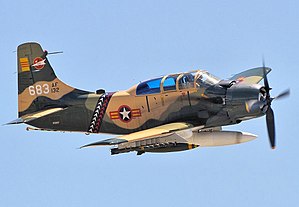
The A-10 was intended to improve on the performance of the A-1 Skyraider and its lesser firepower. The A-10 was designed around the 30 mm GAU-8 Avenger rotary cannon. Its airframe was designed for durability, with measures such as 1,200 pounds of titanium armor to protect the cockpit and aircraft systems, enabling it to absorb a significant amount of damage and continue flying. Its short takeoff and landing capability permits operation from airstrips close to the front lines, and its simple design enables maintenance with minimal facilities. The A-10 served in the Gulf War, the American led intervention against Iraq's invasion of Kuwait, where the A-10 distinguished itself. The A-10 also participated in other conflicts such as in Grenada, the Balkans, Afghanistan, Iraq, and against Islamic State in the Middle East. The A-10A single-seat variant was the only version produced, though one pre-production airframe was modified into the YA-10B twin-seat prototype to test an all-weather night capable version. In 2005, a program was started to upgrade remaining A-10A aircraft to the A-10C configuration.
**************************
Air Force Materiel Command said in a press release on Monday that 162 A-10s received new wings thanks to a $1.1 billion project that began in 2011.
The contract, awarded to Boeing in 2007, required the creation of new parts for the plane’s fuselage.
More @ The Washington Times

Few Defense Department dollars have been as well spent and garnered as good a return on investment as the A 10 program. Perhaps only the B 52 program has given us a bigger bang for the buck.
ReplyDeleteI'll vote for the B-52.:) When we stopped at Clark AFB on the evacuation, some of the women who helped the refugees were American wives of B-52 pilots and they stated their husbands wanted to go back if only given the authorization. :(
DeleteWOW, I'm surprised the air force boys managed to pull their heads out of their ass. Keeping the A-10 is smart. The A-10 is probably one of the best air-frames made since the 60s. Sure we make flashy fighters with all the cool toys. But the A-10 was designed to work. Not just look good and land some cushy gig after retirement.
ReplyDeleteBadger
WOW, I'm surprised the air force boys managed to pull their heads out of their ass.
DeleteMe too.
pulling a USAF head from ass is very difficult and time consuming to accomplish a level of difficulty only exceeded by the standards of pulling a USN aviator head from an ass. Sadly, it is impossible to prevent the insertion. Fighter pilots only have eyes for swoopy airframes and shiny blinky lights. They usually forget about the troops on the ground who need the support of air to mud on call when they need it right now. Pilots who have been in a low, slow slogging air to mud battle ensconced in the front seat of an A-10 usually wouldn't want to go to battle in anything else. the speedy F-16 is very good at it, but when down low and slow and less than 300kts, the A-10 wins. At 350 to 600kts, you have to give it the Lawn Darts.
Deletefrom a purely actuarial point of view, the A-10 costs one fifth to operate vs an F-35 and can carry several times the ordnance to the FEBA. Add to that the F-35 airframe is not as damage tolerant and will shorten its operating lifespan by operating in the rough air of fast and low. Such a delicate little turd. If you get the idea that I am not a proponent of the F-35 or most things Lockheed( I make an exception with the F-22 which they didn't build enough of), you may be correct.
Thank you and a great question to ask pilots of the A-10:
Deletewould you take the Skyraider over the F-35?